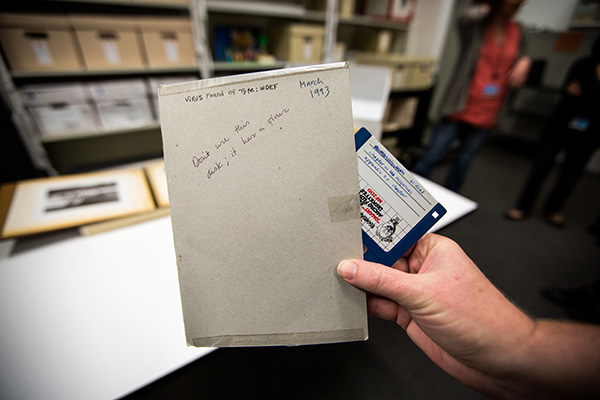
The Getty’s Institutional Archives powerhouse. From left: Jennifer Thompson, Sara Seltzer, Nancy Enneking, Lorain Wang, Helen Kim.
Every workplace produces documents, emails, books, objects, and who knows what else. At the Getty, we produce lots and lots of them. Deciding which of these to keep, which to throw away, and how to catalogue and preserve the good stuff for the future is a team of five crack archivists led by the indefatigable Nancy Enneking, our very own head of Institutional Archives. We asked her to dish about her job.
What exactly are “institutional archives,” anyway?
The Getty’s Institutional Archives is part of the Getty Research Institute, but it documents the work and history of the entire Getty itself, as opposed to documenting art history and artists, as the Research Institute’s special collections does.
We keep the records of everything from the grants the Getty awards, to the conservation work we do on cultural heritage sites internationally, to the events and exhibitions we put on, to the construction of the Getty Center itself. Increasingly, the records we are preserving are a complex hybrid of both paper and digital material.
What do you throw away, what do you keep, and why?
As is true of every organization, much of the everyday documentation produced at the Getty does not have long-term value. We’ve created a document called a Records Retention Schedule to help tell us what to keep and for how long. A subset of these records end up being kept permanently in the archives, based on their ongoing usefulness for business purposes, or historical research.
Who are the archives for and why are they important?
Right now the archives are most often used by Getty staff, but as the records reach a certain age and are processed, more and more material will open to the public. In the decades ahead we believe the Institutional Archives holdings will be a treasure trove of material for the study of the management of art and cultural heritage material during the 20th and 21st centuries.
Tell us the most exciting recent addition to the archives.
The material we’ve been most excited to receive recently are the project files for the work the Getty Conservation Institute did in the Egyptian tomb of Nefertari. The records are currently in the middle of being processed and, hopefully, we’ll be able to make some of it public in the next year or so.
What’s the biggest object in the archive? The smallest? The weirdest?
Our largest objects are architectural models that were created during the construction of the Getty Center and the renovation of the Villa. The smallest are e-mail messages. The most amusing is a floppy disk marked “This disk has a virus; do not use it” that had been sent to storage and that we found in pristine condition 15 years later! It isn’t actually part of the collection, but it’s fun anyway.

Nancy Enneking reviews an old model of the Getty Center.

Nancy makes choices about what gets kept or discarded as part of Getty history.
Share a question you wish people would ask you about your job.
Honestly, I’m happy to answer any question about my job and how our department does what we do! [Editor’s note: this is why archivists are awesome.]




Hi I am a librarian and i am assigned in a Noser Archives Library.
I have raw material of books, photographs and documents written by Germans in World war 1 pre world war, past missionaries who first came to the shores of Madang in Papua New Guinea…. All these are written in German language.. I am now into scanning all these books which has something on PNG.
M question is can you give me a brief on how you would keep these records once scanned, how are other ways to do a backup on these record?